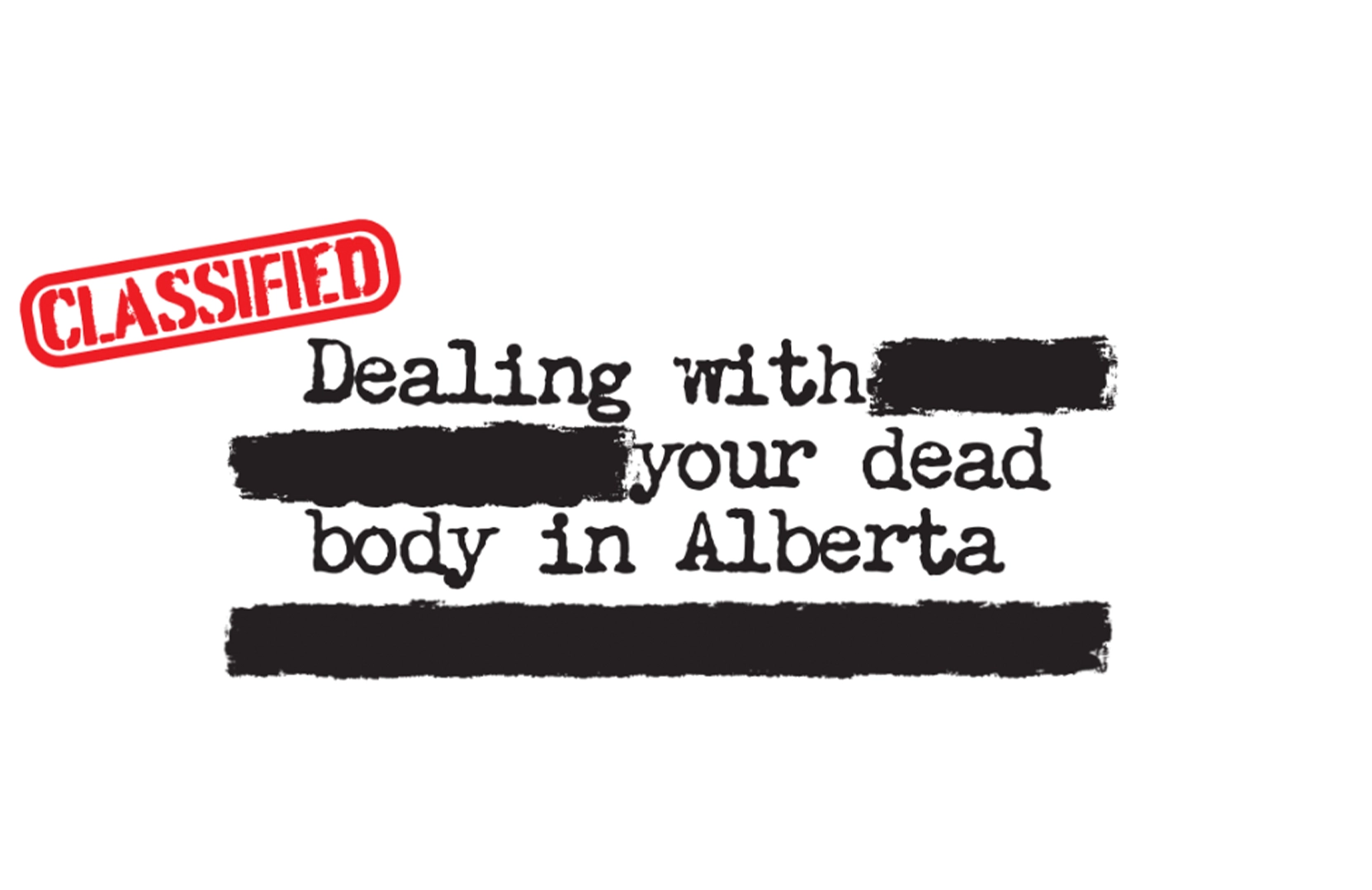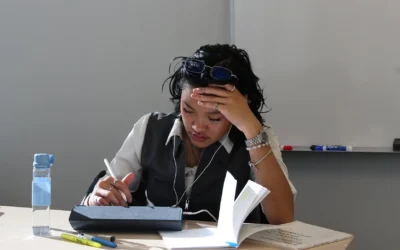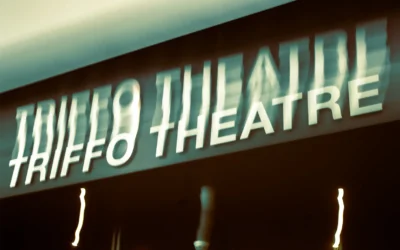Midterms got you stressed? Too much caffeine giving you some eerie heart palpitations? Learn about dying here!
Originally published on October 1, 2024
Hey you! How are you going to deal with your dead body?
While you’re alive, you have the responsibility to plan the disposition of at least one human corpse — yourself. Death can knock at your door anytime, whether you like it or not. If you don’t have any plans yet for your body, you’re making a grave mistake.
But, you’re in luck!
As sustainable disposition alternatives continue to gain traction, Albertans will have more options than ever before to pick from before their expiration date. Today is as good a day as any to buck up, be a good host, and prepare for Death’s arrival.
The Conventional Disposition Methods of Today, and their History
All of our ancestors have hosted Death. Why use precious time and resources to dispose of a body in the first place? Well, disposition started to fulfil basic necessities for the living: to mourn, treat a loved one’s body with respect, and protect oneself from the unpleasant health hazard of decay.
“Since the dawn of the human species, we’ve been caring for our own dead,” says Pashta MaryMoon, the co-founder, treasurer, and executive director of the Canadian Integrative Network for Death Education and Alternatives (CINDEA). If you go back in time around 100,000 to 120,000 years in the Qafzeh Cave in Israel, you’ll find freshly disturbed sediment on top of some of the oldest known burials of human remains with the same modern anatomy as ours. The oldest known human cremation was performed on one of the oldest human remains found in Australia. She was given the name Mungo Lady. I know it’s not polite to tell a lady’s age, but for your education’s sake, she’s around 40,000 years old.
“Since the dawn of the human species, we’ve been caring for our own dead.”
Pashta MaryMoon, co-founder, treasurer, and executive director of CINDEA.
The most common disposition methods used by Canadians are burial and cremation. In the 1960’s, less than five per cent of American people chose cremation. Today, over three quarters of people who die are cremated. The Cremation Association of North America predicts that by 2028, 8 out of 10 decedents will be cremated in Canada.
Kirstie Smolyk is a third generation funeral director, and president of the family owned Park Memorial Funeral Home. Thanks to embalming, she has worked with families who were able to travel from out of the country to attend a service three to four months after the decedent’s passing. “We always recommend to every family to have a visitation with your loved one if they choose to…it’s very important, we feel, to be able to say goodbye,” she says.
The Downsides to Conventional Disposition
Juliette O’Keeffe is a senior scientist at the National Collaborating Centre for Environmental Health (NCCEH), which identifies gaps in knowledge on disposition methods. In 2023, she published her paper Alternative disposition services, with a focus on three kinds of disposition: Green burial, alkaline hydrolysis, and human composting. We will get into the details of all three later, but for now, we’ll be sharing some of the negative impacts O’Keeffe lists to cremation and burial.
One main concern for cemeteries is to make sure water doesn’t go through someone’s decomposing body, extract some of their goop, and meander to a nearby water source. That’s called leachate. Embalming fluid, for example, runs the risk of releasing “biological or chemical contaminants.”
“[A] cemetery requires some kind of upkeep, landscaping, pesticide use, lawnmowers, these types of things that have some kind of environmental impact as well,” says O’Keeffe. Any material used for conventional burial has a traceable impact, like the inherent carbon footprint of sourcing and transporting materials like headstones from mountains or lumber for caskets.
Some of the main concerns of cremation are air pollutants and the consumption of energy. “With increasing density in urban centres, people do not want flame cremation necessarily in their backyard, next to their schools, close to residential developments, so it becomes less publicly acceptable,” says O’Keeffe.
Back to the Future: Green Burial
Green burial is essentially the bare bones of a conventional burial, like the oldest known burials in the Qafzeh Cave.
“So, everything that is used in the green burial is all natural,” says Jenelle Moore, a funeral director, embalmer, and assistant manager of Trinity Funeral Home. Non-embalmed dead are buried in biodegradable materials, like a cloth shroud or a wicker container “A lot of people are very interested in it. I think it’s something that people have wanted for quite some time.”
The Green Burial Society of Canada was founded in 2013, and lists 14 certified green burial sites across the country, including Aurora Gardens at Northern Lights Cemetery in Edmonton.
When a family does choose a green burial, Smolyk encourages a visitation as soon as possible. She says, “There’s no exact rule as to how a body will start to deteriorate. So, in some cases, it can be really fast. In some cases not so much. It just depends on the person.”
“Just gain as much knowledge as possible so that you can make the best decision for yourself and any family members or children that you may be leaving behind.”
Jenelle Moore, funeral director, embalmer, and assistant manager of Trinity Funeral Home.
When a family comes to Smolyk with interest in a green burial, it’s up to her to figure out just how green they’d like to go. Some of the terms and conditions to green burial might not be worth it to your family, and that’s okay. She says, “families need to be educated about all the choices that come along with green burial.” For instance, markers aren’t usually permitted within green burial grounds, and neither is buddying up for eternity with your spouse. You don’t get a choice on your grave neighbour. “What they do is they bury people in the order that they die,” says Smolyk.
Like with the alternative dispositions to follow, Canada’s access to green burial has some catching up to do. The U.S., for instance, has easily over a hundred green burial sites, according to US Funerals Online. MaryMoon says the case for more green burials is not in the hands of legislation, but rather municipalities who decide land use.
Sustainable disposition alternatives coming (not so) soon
“I think there’s room for more choices for families in the future,” says Smolyk.
For instance, MaryMoon’s work with CINDEA is rooted in the pan-death movement. “Its approach is more holistic than conventional choices,” says MaryMoon, listing a few examples such as death doulas, hospice, aromatherapy for people who are dying, and home funerals.
MaryMoon focuses on home funerals, during which she teaches families to take care of their own deceased loved one’s at home. “And that’s still a pretty taboo thing to keep the dead body at home for several days and take care of it yourselves,” she says. “There are some people who are very edgy about it, and they came out of it saying there’s no other way to do it.”
When it comes to seeing a dead body as it progresses naturally, MaryMoon has a different perspective than Smolyk, saying, “It’s like funeral directors are trained that ordinary people cannot handle being around a dead body. You know, unless it’s embalmed and made to look like it’s still alive, just sleeping. And the reality is it’s not true at all. Children are perfectly okay. Children have an easier time with it.”
While baby boomers prefer the more traditional burials, Moore says, “I think moving forward…whatever the smallest footprint available is what people will be looking for.”
Let’s say you choose alkaline hydrolysis as your disposition method. This means you will be placed in a high alkaline solution, essentially a basic solution on the pH scale. Heat and pressure will be added to the mix. Your body will dissolve in the solution until all that’s left is bone that’ll be crushed and brought to your family. Meanwhile, the solution will be neutralised, and then poured down the drain.
At the time of writing, Ontario, Quebec, Saskatchewan, Newfoundland and Labrador, and the Northwest Territories all permit alkaline hydrolysis. Some provinces, like Saskatchewan, have opened up their definition of cremation to include alkaline hydrolysis. While this process is estimated to use around 1/7th to 1/8th of the energy of flame cremation, it has its own disadvantages. Many water treatment plants employ a biological process to filter sewage. O’Keeffe says if a high alkaline solution hits a small treatment plant it could disrupt that system.
The last alternative disposition method on the agenda to discuss is human composting, also known as terramation. This method entails, well, you guessed it, composting the dead. Canada has yet to adopt any legislation for human composting. Our neighbours to the south have rules for human composting across at least six states. With Return Home, a terramation company based out of Auburn, Washington, the process takes two to three months and the end product, nutrient rich soil, is returned to families. In an email to the Griff, Return Home confirmed they have, “served a number of Canadian families to date,” by having families ship the deceased across the border.
Waiting on legislation
Funeral homes range from corporations, private, and family owned. Regardless,, the Alberta Funeral Services Regulatory Board (AFSRB) ensures every funeral director and embalmer is licensed. To do so, AFSRB administers tests and continuing education.
“A lot of the decisions made within the funeral industry are not made by people who are in the funeral industry,” says Moore.
The Government of Alberta has assigned AFSRB the task of administering the following legislation: Funeral Services Act, Funeral Services Act General Regulation, Funeral Services Act Exemption Regulation and the Crematory Regulation under the Cemeteries Act.
“Not every province is licensed with alkaline hydrolysis right now, but I expect all provinces probably will be at some point in the future, we just don’t know when,” says Smolyk.
“I think it’s going to take some time,” says Moore. “I think it’s going to rumble through for a little bit. And I think there’s going to be a lot of talk about it and who can and how it happens. But I don’t think it’s going to happen any time quickly, for sure.”
In their email, Return Home said, “When it comes to the Canadian legislative process, it is a complex and evolving landscape.”
Your Advice? Don’t be Afraid of Death, Talk About It.
As with anything in life, preparation is key. “I honestly think people are afraid to talk about it because they think it’s going to happen if they talk about it,” says Moore.
“Two year olds die, you know, along with the 90 year olds, and so do 20 year olds. So I think the hardest part for a lot of these families that have never talked about it is not knowing what their loved one wanted and struggling over those decisions,” says Smolyk.
When it comes to funding your demise, Moore encourages students to know what they want, look at various insurance policies if/when they’re employed, and to start, “putting a few dollars away here and there.”
“Just gain as much knowledge as possible so that you can make the best decision for yourself and any family members or children that you may be leaving behind,” says Moore.
Your body’s disposition is the last wish for your time on this planet. It’s a wholeheartedly individual decision. So make it count, however that looks for yourself and those who will mourn you.
Graphic by Forrester Toews





0 Comments